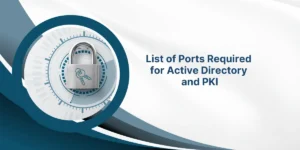What is Port 636?
Port 636 is a well-known port number primarily used for secure LDAP (Lightweight Directory Access Protocol) connections over TLS/SSL (Transport Layer Security/Secure Sockets Layer). LDAP is an application protocol used for accessing and maintaining directory services over an IP network.
The use of port 636 enables LDAP traffic to be encrypted through TLS or SSL, providing confidentiality and integrity protection for sensitive directory information that may be exchanged during LDAP sessions between clients and servers.
Key Takeaways
- Port 636 is used for secure LDAP over TLS or SSL to protect sensitive directory information.
- It provides encryption, integrity protection, and authentication for LDAP traffic.
- This port is commonly used with Microsoft Active Directory deployments.
- Blocking port 636 will likely break LDAPS services that rely on it for secure LDAP communication.
- Proper firewall rules need to be configured to allow legitimate traffic over port 636.
- LDAPS connections require valid certificates to be trusted on both client and server sides.
- Alternate ports like 636 and 3269 may be used for secure LDAP/GC traffic.
- LDAPS is recommended over plain LDAP for security reasons in most environments.
What is LDAP and How Does it Work?
LDAP stands for Lightweight Directory Access Protocol. As the name suggests, it is an application protocol used for accessing and maintaining directory services over an IP network.
A directory service stores information about users, systems, networks, services, or any other resources over the network. It provides a centralized repository where this information can be securely stored and retrieved from.
Some common uses of LDAP include:
- User authentication: LDAP directories are used to authenticate user credentials for system and network access.
- Storing user profiles—User account details, such as full names, contact info, groups, etc., are stored in an LDAP directory.
- Organizational information: Details about departments, roles, permissions, etc., can be stored in an LDAP directory.
- Certificate storage: LDAP can store and retrieve digital certificates used in public key infrastructure (PKI).
- Network configuration: LDAP can hold information about network resources like routers, switches, and IP addresses.
At a protocol level, LDAP is designed to be lightweight and work over TCP/IP networks. It utilizes a client-server model where LDAP clients connect to and query information from an LDAP server. The default LDAP port is 389.
Clients send LDAP requests to the server, which processes them and sends responses back. LDAP supports various operations, such as search, add, delete, modify, and compare, to manage directory entries.
Why Use Port 636 for LDAP?
By default, LDAP communication happens in cleartext over standard TCP port 389. This means LDAP packets travel unencrypted over the network.
Anybody with network access could intercept LDAP traffic and gain access to sensitive directory information. User credentials, passwords, certificates and other confidential data may get exposed.
LDAPS was introduced to make LDAP communication more secure. The “S” stands for “Secure,” indicating that LDAP is now tunneled over an encrypted SSL/TLS channel.
Port 636 is the default TCP port assigned for establishing LDAPS connections. Running LDAP over port 636 enables:
- Encryption of LDAP payloads over TLS or SSL
- Integrity protection by verifying packet contents have not been altered
- Authentication of the LDAP server’s identity
This prevents malicious attackers from interception or tampering with LDAP data, securely transferring sensitive directory information over the network.
Most organizations leverage LDAPS with port 636 for their production LDAP/Active Directory deployments. Using plain LDAP is only acceptable in trusted internal network segments.
How Does LDAPS with Port 636 Work?
Here is how a typical LDAPS session works when communicating over port 636:
- The LDAPS client initiates a TCP connection to the LDAPS server on port 636.
- The server presents its SSL/TLS certificate to the client for verification.
- The client validates the server certificate against its trusted certificate authority (CA) store.
- If the certificate is trusted, the client and server negotiate an encrypted SSL/TLS channel.
- All subsequent LDAP payload data flowing over this TCP connection is now encrypted using symmetric keys.
- The client sends LDAP requests within encrypted TLS records over port 636.
- The server unpacks the encrypted data, processes the LDAP requests, and sends back LDAP responses within encrypted TLS records.
- This continues until the LDAPS session is terminated and the TCP connection closes.
The encryption, integrity protection, and server authentication provided by LDAPS prevent man-in-the-middle attacks and eavesdropping.
Many organizations only permit LDAPS access and block plain LDAP when external network connectivity is involved.
What are the Common Uses of Port 636
Here are some of the most common uses and applications that leverage port 636 for secure LDAP communication:
Microsoft Active Directory
Microsoft Active Directory domain controllers listen on port 636 for secure LDAP traffic by default. Windows clients use LDAPS when connecting to domain controllers for user authentication and directory lookups.
Active Directory Certificate Services (ADCS) also relies on LDAPS for issuing and managing PKI certificates.
Directory Services Replication
LDAPSync replication between multi-master OpenLDAP servers or Active Directory sites utilizes LDAPS connections over port 636.
Network Devices
Many routers, switches, firewalls, and load balancers use LDAP to store device configuration and credentials. For security, they often connect to the LDAP server over port 636.
LDAP Proxies
LDAP proxy servers that aggregate multiple directories typically listen on port 636. This allows clients to securely access the backend LDAP servers via LDAPS.
VPN Authentication
Some VPN solutions integrate with LDAP directories for user authentication. They may leverage LDAPS on port 636 to query the directory securely.
Linux PAM Authentication
Pluggable Authentication Modules (PAM) on Linux can be configured for LDAPS authentication to Active Directory or OpenLDAP servers using port 636.
Cloud Directories
Cloud directory services like Amazon Directory Service and Azure Active Directory Domain Services expose LDAPS endpoints on port 636.
Federated Identity
Identity federation protocols like SAML, OAuth and OpenID Connect may rely on LDAPS for identity information lookup using port 636.
As you can see, port 636 is widely used in directory services, identity management, network security, and authentication systems.
What are the Key Considerations for Port 636 Usage
Here are some key points to consider when utilizing port 636 for secure LDAP/LDAPS:
- LDAPS can only be used once a valid TLS/SSL certificate has been installed on the LDAP server. Self-signed certificates will not work.
- A trusted certificate authority like an internal PKI or external provider must sign the LDAPS certificate.
- The certificate subject name should match the LDAP server DNS name that clients will specify in their connection URL.
- Client machines need to have the root and intermediate certs of the signing CA in their trust stores.
- No plaintext binds are permitted over LDAPS. Anonymous or SASL binds must be used.
- Backup LDAP server connections should also use port 636 for redundancy.
- Firewalls must allow bi-directional TCP traffic over port 636 between LDAP clients and servers.
- Alternative ports like 10636 or 30636 may be used, but 636 is the standard.
- Consider using StartTLS on port 389 if deploying LDAPS globally is an issue.
How to Check if Port 636 is Open
Checking if port 636 is open and accessible is important when troubleshooting LDAPS connectivity issues. Here are a few ways to verify:
- Telnet: Run “telnet server 636” to check if a TCP connection can be established.
- Netcat: Use “nc -zv server 636” to see if the port is open and responding.
- PowerShell: Run “Test-NetConnection server -Port 636” to check the port.
- Linux: Use “nmap -p 636 server” or “nc -vz server 636” to scan the port state.
- Curl: Perform an LDAPS query like “curl -kldaps://server:636” to see if the request succeeds.
- OpenVAS: Active vulnerability scanners like OpenVAS can be used to scan for open LDAPS ports.
- Wireshark: Analyze packet captures to see if LDAPS traffic is flowing over port 636 as expected.
How to Allow Port 636 in the Firewall
For secure LDAPS access over port 636 to work properly, the corresponding firewall rules need to be configured both on network firewalls and host systems:
- Create a new ingress + egress TCP firewall rule allowing port 636
- Specify source + destination subnets between LDAP clients and LDAP servers
- Set action to “Allow” for the new rule
- Place the rule above any blanket deny rules in the ruleset
- Adjust priority as needed to avoid rule conflicts
- Add the LDAPS server as a “Trusted” host if required
- For Linux iptables: iptables -A INPUT -p tcp –dport 636 -j ACCEPT
- For Windows firewall: netsh advfirewall firewall add rule name=”LDAPS” dir=in action=allow protocol=TCP localport=636
- Check for any host-based rules denying port 636 and modify them
- Confirm LDAPS connectivity over port 636 works after the changes
Troubleshooting LDAPS with Port 636
Some common issues faced when establishing LDAPS communications over port 636 include:
- Certificate problems: An Invalid, expired, or untrusted LDAPS certificate will cause verification errors. Ensure a valid CA-signed certificate is installed on the LDAPS server, and that clients trust the CA certificate.
- TLS negotiation failure: Mismatched cipher suites or TLS versions could lead to TLS handshake failure between client and server. Double check LDAPS encryption settings on both sides.
- Connection timeouts: A firewall blocking port 636 or network instability can result in connection timeouts. Check port access and network conditions.
- Authorization issues: Clients may fail SASL authentication or lack permissions to access LDAPS directory data. Review client identity, access controls, and bind configurations.
- Unreachable hosts: Wrong LDAPS server IP, hostname resolution problems, or routing issues can lead to unreachable host errors. Verify LDAPS endpoint details and network connectivity.
- SSL decoding errors: Some LDAP client libraries may not support decoding TLS-encrypted LDAP payloads over port 636. Use libraries with SSL/TLS support.
- Congestion and latency: Heavy network congestion or high latency links can negatively impact LDAPS sessions over TCP port 636. Optimize network traffic flow and shape bandwidth if needed.
What are the Alternatives of Port 636 for Secure LDAPS
While port 636 is the standard for LDAPS, sometimes alternatives may be used instead:
- TCP Port 3269: Used for LDAPS communication with Active Directory global catalog servers. Provides secure AD GC lookup for logon operations.
- TCP Port 10636: Alternative LDAPS port registered with IANA. Rarely used but can substitute port 636 if needed.
- TCP Port 30636: Another registered alternative for LDAPS connections, but very uncommon.
- TCP Port 389 + StartTLS: Plain LDAP upgraded to TLS encryption using StartTLS extended operation. It is not as robust as natively encrypted LDAPS sessions.
- Different Custom Port: Depending on their security posture, Organizations may sometimes use a custom firewall-protected port for LDAPS traffic.
- HTTP+TLS on Port 443: Running LDAPS over HTTPS can bypass port blocking but adds TLS encryption overhead.
Evaluate if alternatives like custom ports or HTTP+TLS may be required in your environment if standard port 636 cannot be opened.
How to Implement Secure LDAPS with Port 636
Here are key steps to securely implement and configure LDAPS using port 636:
- Obtain a valid SSL/TLS certificate from a trusted CA, such as an internal PKI or third-party issuer, and install it on your LDAPS server.
- Enable TLS encryption on the LDAP server software and select the installed certificate. Enforce using only TLS v1.2 or higher with strong ciphers like AES-256.
- Configure clients to use “ldaps://” URLs instead of “ldap://” for connections.
- Open firewall ports 636 (and 3269 for GC if using Active Directory) between your clients and LDAPS server(s).
- Ensure root and intermediate CA certificates are trusted on client machines for validating the LDAPS certificate.
- Consider disabling plain text LDAP to enforce LDAPS for enhanced security, if feasible, in your environment.
- Monitor LDAPS activity through your SIEM solution and implement inspection on your network.
- Set up LDAPS high availability between multiple LDAPS servers if redundancy is required.
Final Thoughts
In closing, port 636 plays a critical role in providing secure LDAPS communication for protecting confidential directory data. The TLS encryption and server authentication offered by LDAPS over port 636 provide strong protection against many security threats faced by plaintext LDAP traffic. Organizations worldwide leverage port 636 for hardening access to sensitive identity stores and achieving compliance.
However, proper implementation requires factors like firewall rules, trusted certificates, and client configurations to be set up correctly. In the future, LDAPS on port 636 will continue to be a foundational protocol for safeguarding directory services as part of a defense-in-depth strategy. Implementing LDAPS should be a priority for any organization using LDAP-based directories to maximize the security and privacy of sensitive directory data.
Frequently Asked Questions about Port 636
Is port 636 TCP or UDP?
Port 636 is a TCP port since LDAPS uses TCP connections for the reliable transport of directory data. UDP is not used for LDAP.
What is the difference between port 389 and 636?
Port 389 is used for unencrypted plain LDAP communication. Port 636 is used for secure LDAPS communication encrypted over TLS/SSL.
Can you use port 636 for non-SSL LDAP traffic?
No, port 636 is registered and reserved specifically for LDAP over TLS/SSL. Plain unencrypted LDAP should use the default port 389.
What is an LDAPS certificate?
An LDAPS certificate is an X.509 server certificate issued by a trusted certificate authority. It allows the LDAP server to authenticate itself and establish TLS-encrypted channels for protecting LDAP traffic.
What gets logged in LDAPS over port 636?
Connection information, session metadata, LDAP operations, errors, etc., can get logged on both the LDAPS client and server sides during communications over port 636. Sensitive data is not logged.
Is LDAP or LDAPS more secure?
LDAPS is much more secure than plain LDAP, as the TLS encryption provided by LDAPS on port 636 protects the integrity and confidentiality of LDAP payloads as they traverse untrusted networks.
What are some clients that use port 636?
Microsoft Active Directory, OpenLDAP clients, Apache Directory Studio, LDAP browser utilities, Java LDAP SDKs, .NET DirectoryServices, PowerShell, etc, all leverage port 636 for secure LDAPS connections.

Priya Mervana
 Verified Web Security Experts
Verified Web Security Experts
Priya Mervana is working at SSLInsights.com as a web security expert with over 10 years of experience writing about encryption, SSL certificates, and online privacy. She aims to make complex security topics easily understandable for everyday internet users.



